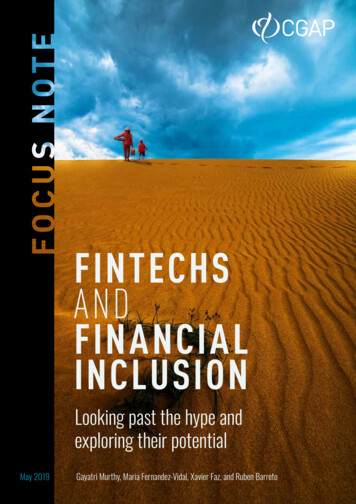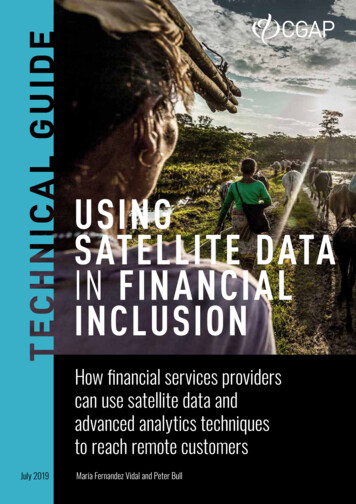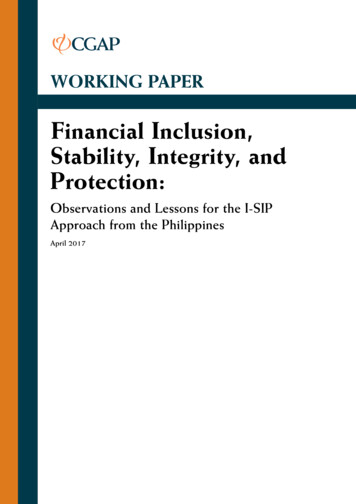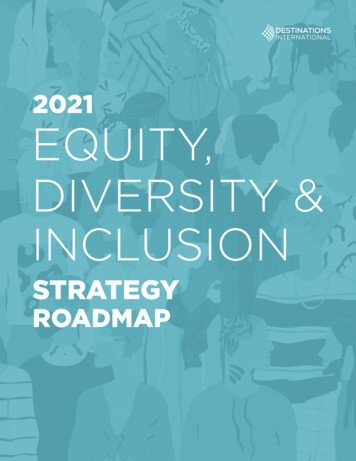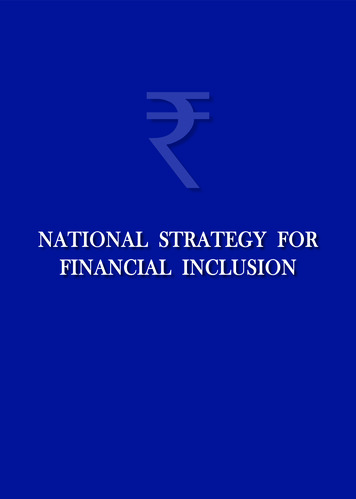
Transcription
National Strategy forFinancial Inclusion
The National Strategy for FinancialInclusion 2019-2024 sets forththe vision and key objectives ofthe financial inclusion policies inIndia to help expand and sustainthe financial inclusion process atthe national level through a broadconvergence of action involvingall the stakeholders in the financialsector.National Strategy forFinancial Inclusion2019-2024An approach paper to accelerate financial inclusionThe strategy aims to provideto promote economic wellbeing, prosperity andaccesssustainable developmenttoformalfinancialservices in an affordable manner,broadening & deepening financialinclusion and promoting financialliteracy & consumer protection.
VisionUniversalAccess to FinancialServicesProviding BasicBouquet ofFinancial ServicesEffectiveCo-ordinationTo make financial servicesavailable, accessible, andaffordable to all the citizens in asafe and transparent manner tosupport inclusive and resilientmulti-stakeholder led s toLivelihood andSkillDevelopmentFinancialLiteracy andEducation
oss Country Analysis and Lessons04III.Status of Financial Inclusion in India08IV.Strategic Objectives17V.Recommendations24VI.Measurement of Progress of Financial Inclusion26VII. ConclusionBibliography3336
List of Select AbbreviationsAPBSAadhaar Payment Bridge SystemFLCFinancial Literacy CentreAEPSAadhaar Enabled PaymentSystemFIACFinancial Inclusion AdvisoryCommitteeAFIAlliance for Financial InclusionFIFFinancial Inclusion FundANBCAdjusted Net Bank CreditFIPFinancial Inclusion PlanATMAutomated Teller MachineFSDCAPYAtal Pension YojanaFinancial Stability andDevelopment CouncilBCBusiness CorrespondentGCCGeneral Credit CardBLBCBlock Level Bankers CommitteeGPFIBSBDABasic Savings Bank DepositAccountGlobal Partnership for FinancialInclusionG2PGovernment to PersonCBSECentral Board of SecondaryEducationIBAIndian Banks’ AssociationIFIIndex of Financial InclusionCBKCentral Bank of KenyaIIBFCCCCertified Credit CounsellorsIndian Institute of Banking andFinanceCDDCustomer Due DiligenceIMFInternational Monetary Fund /Insurance Marketing FirmsCFLCentre for Financial LiteracyIMPSImmediate Payment ServiceCGAPConsultative Group to Assist thePoorINFEInternational Network forFinancial EducationIPPBIndia Post Payments BankISPInsurance Service ProviderIRInsurance RepositoryIGNOAPSIndira Gandhi National Old AgePension SchemeICTInformation and CommunicationTechnologyIRDAIInsurance Regulatory andDevelopment Authority of IndiaJAMJan Dhan- Aadhaar-MobileKYCKnow Your CustomerLDOLead District OfficerLWELeft Wing ExtremistsMISManagement Information SystemMGNREGAMahatma Gandhi National RuralEmployment Guarantee ActMoFMinistry of FinanceMSMEMicro, Small and MediumEnterprisesCKYC Registry Central Know Your CustomerRegistryCMPFICommittee on Medium Term Pathon Financial InclusionCONAIFNational Council for FinancialInclusionCSCCommon Service CentreCTSCheque Truncation SystemDAYDeendayal Antyodaya YojanaDAY-NULMDeendayal Antyodaya YojanaNational Urban Livelihood MissionDBTDirect Benefit TransferDCCDistrict Consultative CommitteeDCCBDistrict Central Co-operative BankDDU-GKYPt. Deen Dayal UpadhyayaGrameen Kaushalya YojanaDFSDepartment of Financial ServicesDLRCDistrict Level Review CommitteeFAMEFinancial Awareness Message
NACHNational Automated ClearingHouseNAMCABSNational Mission for CapacityBuilding of Bankers for FinancingMSME SectorNABARDNational Bank for Agriculture andRural DevelopmentPMMYPradhan Mantri Mudra YojanaPMSBYPradhan Mantri Suraksha BimaYojanaPFRDAPension Fund Regulatory andDevelopment AuthorityPSGICPublic Sector General InsuranceCompaniesNEFTNational Electronic Fund TransferNERNorth Eastern RegionRoCRegistrar of CompaniesNCFENational Centre for FinancialEducationRTGSReal Time Gross SettlementNFISNational Financial InclusionStrategyRXILReceivables Exchange of IndiaRBIReserve Bank of IndiaNPCINational Payments Corporation ofIndiaSCScheduled CasteNGONon-Government OrganisationSTScheduled TribeNPSNational Pension SystemSEBINRLMNational Rural LivelihoodsMissionSecurities and Exchange Board ofIndiaSFBSmall Finance BanksNSFINational Strategy for FinancialInclusionSIDBISmall Industries DevelopmentBank of IndiaNULMNational Urban LivelihoodsMissionSLBCState Level Bankers’ CommitteeNWRNegotiable Warehouse ReceiptsSMESmall and Medium EnterprisesOECDOrganisation for Economic Cooperation and DevelopmentSPVSpecial Purpose VehicleSRLMState Rural Livelihoods MissionTGFIFLTechnical Group on FinancialInclusion and Financial LiteracyTReDSTrade Receivables DiscountingSystemUFAUniversal Financial AccessUIDAIUnique Identification Authority ofIndiaUNSDGUnited Nations SustainableDevelopment GoalsPACSPrimary Agricultural Co-operativeSocietyP2BPerson to BusinessP2PPerson to Person/ Peer to PeerP2GPerson to GovernmentPCRPublic Credit RegistryPMEGPPradhan Mantri EmploymentGuarantee ProgrammePMKVYPradhan Mantri Kaushal VikasYojanaPMJDYPradhan Mantri Jan Dhan YojanaUPIUnified Payments InterfacePPFPublic Provident FundUSSDPBPayments BankUnstructured SupplementaryService DataPMJJBYPradhan Mantri Jeevan JyotiBima YojanaWDRAWarehousing Development andRegulatory Authority
National Strategy forFinancial Inclusion
I IntroductionI.1Financial inclusion is increasingly being recognized as a key driver of economic growthand poverty alleviation the world over. Access to formal finance can boost job creation, reducevulnerability to economic shocks and increase investments in human capital. Without adequateaccess to formal financial services, individuals and firms need to rely on their own limited resourcesor rely on costly informal sources of finance to meet their financial needs and pursue growthopportunities. At a macro level, greater financial inclusion can support sustainable and inclusivesocio-economic growth for all.I.2There has been a growing evidence on how financial inclusion has a multiplier effect inboosting overall economic output, reducing poverty and income inequality at the national level.Financial inclusion of women is particularly important for gender equality and women’s economicempowerment. With greater control over their financial lives, women can help themselves and theirfamilies to come out of poverty; reduce their risk of falling into poverty; eliminate their exploitationfrom the informal sector; and increase their ability to fully engage in measurable and productiveeconomic activities. An inclusive financial system supports stability, integrity and equitablegrowth. Therefore, financial exclusion because of several barriers like physical, socio-cultural andpsychological, warrants attention from the policy makers. Some of the key reasons resulting ininvoluntary exclusion are:Figure I.1 - Causes of Financial ExclusionLack of surplusincomeNot suitable tocustomer’srequirementsLack of requisitedocumentsLack of awarenessabout the productLack of trust in thesystemHigh transactioncostsRemoteness ofservice providerPoor quality ofservices renderedIntroduction1
Financial Inclusion and United Nations Sustainable Development GoalsI.3It is also noteworthy to state that, seven1 of the seventeen United Nations SustainableDevelopment Goals (SDG) of 2030 view financial inclusion as a key enabler for achievingsustainable development worldwide by improving the quality of lives of poor and marginalizedsections of the society. (Home- Sustainable Development Goals, 2018)Defining Financial Inclusion in the Indian ContextI.4Financial inclusion has been defined as “the process of ensuring access to financial services,timely and adequate credit for vulnerable groups such as weaker sections and low-income groupsat an affordable cost”. (Committee on Financial Inclusion - Chairman: Dr C Rangarajan, RBI,2008). The Committee on Medium-Term Path to Financial Inclusion (Chairman: Shri DeepakMohanty, RBI, 2015) has set the vision for financial inclusion as, “convenient access to a basketof basic formal financial products and services that should include savings, remittance, credit,government-supported insurance and pension products to small and marginal farmers and lowincome households at reasonable cost with adequate protection progressively supplemented bysocial cash transfers, besides increasing the access of small and marginal enterprises to formalfinance with a greater reliance on technology to cut costs and improve service delivery, .”Financial Inclusion Strategy - RationaleI.5While a lot of efforts have been undertaken to increase financial inclusion in the country(See Chapter III- Status of Financial Inclusion in India) a lot of steps are further needed to ensureadequate access to financial services and usage of these services by various segments of underserved and un-served population in India, so far. Anchored in the country’s development priorities,the NSFI 2019-2024 seeks to address the inherent barriers of access to a gamut of financialproducts and services. An inclusive financial system (ably supported through sound financialinclusion policies, focus on financial education and customer protection) is not only pro-growthbut also pro-poor with the potential to reduce income inequality and poverty, promote socialcohesion and shared economic development. Financial exclusion, on the other hand, leaves thedisadvantaged and low- income segments of society with no choice other than informal options,making them vulnerable to financial distress, debt, and poverty.Eliminating extreme poverty; Reducing hunger and promoting food security; achieving good health and well-being,promoting gender equality; promoting sustained, inclusive and sustainable economic growth, full and productiveemployment and decent work; building resilient infrastructure, promote inclusive and sustainable industrialization andfoster innovation; reduce income inequality within and among countries.See ble-development-goals/12National Strategy for Financial Inclusion 2019-2024
Figure I.2- Inclusion, Literacy and Grievance ncialLiteracyInitiativesThe National Strategy for Financial Inclusion for India 2019-2024 has been prepared byRBI under the aegis of the Financial Inclusion Advisory Committee and is based on the inputsand suggestions from Government of India, other Financial Sector Regulators viz., SecuritiesExchange Board of India (SEBI), Insurance Regulatory and Development Authority of India (IRDAI)and Pension Fund Regulatory and Development Authority of India (PFRDA). This documentalso reflects various outcomes from wide-ranging consultation held with a range of stakeholdersand market players, including National Bank for Agriculture and Rural Development (NABARD),National Payments Corporation of India (NPCI), Commercial Banks and Corporate BusinessCorrespondents etc. It includes an analysis of the status and constraints in financial inclusion inIndia, specific financial inclusion goals, strategy to reach the goals and the mechanism to measureprogress.Introduction3
II Cross Country Analysis and LessonsII.1With increased recognition globally and United Nations Sustainable Development Goals(SDGs) emphasising financial inclusion as a key enabler for achieving sustainable developmentworldwide, countries across the globe are developing suitable strategies and policies to increaseaccess and usage of formal financial services. Achieving Universal Financial Access by 2020 (UFA2020) has been one of the key developmental agenda of the World Bank which aims to provideadults who currently aren’t part of the formal financial system, with access to a transaction accountto store money, send and receive payments to manage their financial lives. (Universal FinancialAccess 2020, 2018) To achieve this ambitious goal, the World Bank Group has committed toenable one billion people to gain access to a transaction account through targeted interventions.It also works with countries to strengthen the following key building blocks: public and privatesector commitment, enabling legal and regulatory framework, and bolstering financial and ICTinfrastructure, and globally, through engagement with standard-setting bodies to come up withrecommendations and guidelines that will advance access to transaction accounts.II.2Each country’s strategy and progress towards financial inclusion is unique because ofsignificant variations in the Government’s priorities, institutional capacity to implement reforms,evolution of financial markets, payments infrastructure, financial capability of people, and culturalbeliefs that drive financial behaviour. Therefore, a mere review of various countries’ financial inclusionpolicies without understanding their socio-economic background, political system, and culture andbeliefs, will not be sufficient to draw insights for designing and developing our own FinancialInclusion strategy. It would nevertheless still be meaningful to look into and draw inferences basedon the experiences and feedback of the financial inclusion policies of other countries. Similar toNational Identity System put in place by various countries, India has also introduced Aadhaar in2009. Recognizing the importance of financial education, the current Strategy considers FinancialEducation as one of the important pillars of the NSFI as visualized by other countries.II.3Globally, the adoption of a formal National Financial Inclusion Strategy (NFIS) has acceleratedsignificantly in the past decade. By mid-2018, more than 35 countries, including Brazil, China,Indonesia, Peru and Nigeria have launched a NFIS and another 25 countries are in the processof developing a strategy. Further, several countries have also updated their original NFIS (WorldBank Group, 2018). Some of the important commonalities observed in the strategies of a fewcountries have been reviewed and are summarised below.4National Strategy for Financial Inclusion 2019-2024
LeadershipII.4A strong leadership (visionary or charismatic) is important to achieve financial inclusiongoals. Financial inclusion policies require time to realize their full potential. Therefore, having along-term vision and a well-coordinated approach is essential.Target Based ApproachII.5Financial inclusion policies are generally targeted towards specific sectors like MSME,Agriculture or specific regions like Aspirational Districts. It is important to develop sector specificaction plans and monitor targets and review the progress.Regulatory FrameworkII.6There should be a strong regulatory and legal framework aimed at protecting the interestsof the customers, promoting fair practices and curbing market manipulations. Further, theregulations should have adequate space to allow flexibility and openness for innovations. Thiscalls for incorporating a Test and Learn Approach in the form of Regulatory Sandboxes along withencouraging Pilot projects to reach long term viability and mitigate losses.Market DevelopmentII.7Market development and deepening thereof, through various regulatory initiatives for cateringto the needs of the target groups is vital. While a Universal Banking system can continue to provideservices to existing clientele, there may also be a case for permitting differentiated entities thatleverage technology to provide low cost, high volume services. The process of market developmentcan be in the form of expansion of rural networks and access points; allowing preferential prudentialrules to encourage lending to rural areas and setting up special sub-branches in rural areas;digitising large-scale payment streams like pension, insurance, and subsidies for rural householdsetc. as also proliferation of new institutions, products and services.Strengthening InfrastructureII.8Development of an ecosystem with requisite infrastructure, including credit infrastructure,receipt and payment infrastructure etc., are essential. Providing a national level identification,setting up a credit registry database, creation of open and inclusive payment systems are someof the key steps in this direction. Putting in place a suitable framework for using national levelidentification number for cashless and paperless financial transactions, based on customerconsent can simplify customer on-boarding and also ease in operations. Further, this facilitates alarge volume of Government to Person (G2P) transactions and vice-versa (P2G), directly throughCross Country Analysis and Lessons5
bank accounts. Development of robust payments infrastructure coupled with regulations can fostercompetition and orderly growth which result in more customer centric products, increased choicesand convenience. Developing a robust credit database also helps lenders to take an informeddecision on the credit proposals.Last Mile DeliveryII.9Focus on Last Mile Delivery has been one of the major thrust areas in various countries.Since the typical rural customer would not be willing to forego his/ her day’s wage to visit a financialservice provider, it is important that distance and resulting time taken to visit the service providerdoes not act as a deterrent. To achieve this, various countries have come up with policies to extendthe receipt infrastructure including permitting formal financial institutions to engage services ofagents and Business Correspondents (BCs). While the Business Correspondents have beenable to reach out to the last mile customer, the issue of customer protection, providing suitableproducts, increasing financial awareness, having a proactive oversight over the activities of theagents and sustainability of the agent/BC network are some of the areas which now require policyinterventions.Innovation and TechnologyII.10 Innovation and Technology in the overall landscape have resulted in rise of fin-tech entitieswhich leverage technology to offer financial services. While these new entities have the potentialto increase competition and provide the customer with greater choice through suitable productsand easier processes, they may also exclude those customers who do not have the basicinfrastructure like internet connectivity and access to smart phones. It is therefore imperative tohave a balance between technology and agents to provide customers with adequate handholding.Since technology evolves very rapidly, oversight on the technology led institutions is of utmostimportance and their regulation needs constant upgradation.Financial Literacy and AwarenessII.11 Financial literacy continues to gather global attention as it is increasingly being realised thatonly an informed customer will be able to take proper financial decisions. Financial literacy enablesa customer to have necessary awareness about the available products, ability to choose the rightproduct and available mechanism for grievance redressal. Emphasis is now on to increase thefinancial awareness among various vulnerable groups in the society viz., women, youth, children,elderly, small entrepreneurs, etc. who require handholding. Focus has been on the developmentof various scientific tools and design approaches combining concept literacy with process literacy.With more and more usage of digital mode of transactions, financial literacy in the realm of digitalfinancial services has assumed importance.6National Strategy for Financial Inclusion 2019-2024
Consumer ProtectionII.12 Considering that the new entrants to the financial system are likely to be more vulnerable,customer protection and grievance redressal has become an important pillar for furtheringsustainable financial inclusion. This is further accentuated by the fact that there has been asteep increase in access to digital financial services which calls for a robust customer protectionframework. Some of the measures undertaken include increased market monitoring, creationof a strong enforcement machinery to redress customer grievances and improved coordinationbetween the financial sector supervisors, particularly relating to cross-product and cross-marketissues.Monitoring and EvaluationII.13 Periodic monitoring and evaluation of the progress made in financial inclusion sphere canhelp in identifying the bottlenecks and also initiate corrective measures. Countries and variousinstitutions are recognizing the need for reliable financial inclusion data, to get an overview onparameters relating to access, usage, and quality of financial services rendered.II.14 Financial inclusion is a much-cherished policy objective for India and its economic policyhas always been driven by an underlying intent of a sustainable and inclusive growth. The nextchapter summarises the initiatives undertaken in India in the financial inclusion domain and ourachievements especially in the light of the foregoing learnings. The chapter also highlights someof the critical challenges that act as barriers for financial inclusion.Cross Country Analysis and Lessons7
III Status of Financial Inclusion in IndiaIII.1The policy makers in India have been aware of the implications of poverty for financialstability and have continually endeavoured to ensure that poverty is tackled in all its manifestationsand that the benefits of economic growth reaches the poor and excluded sections of the society.III.2India began its financial inclusion journey as early as in 1956 with the nationalisation ofLife Insurance companies. This was followed by nationalisation of banks in 1969 and 1980. Thegeneral insurance companies were nationalised in 1972. A review of the status of financial inclusionin India indicates that a host of initiatives have been undertaken over the years in the financialinclusion domain.III.3India has also been actively engaged with other countries and multilateral fora viz. GlobalPartnership for Financial Inclusion (GPFI) and Organization for Economic Co-operation andDevelopment (OECD). India is one of the co-chairs along with Indonesia and United Kingdom inthe GPFI Subgroup on Regulation and Standard Setting Bodies. India has been actively involvedin preparation of relevant research and policy guides in Digitalisation, Regulation and FinancialInclusion that are published by GPFI from time to time. Further, the Reserve Bank of India iscurrently a member of four working groups viz. Standards, Implementation and Evaluation, DigitalFinancial Literacy, Financial Education for MSMEs and Core Competencies for Financial Literacyunder the International Network for Financial Education (INFE), set up under OECD. Keeping inview the various developments in the global front, India has also initiated the process of preparingits National Strategy for Financial Inclusion (NSFI) in June 2017 under the aegis of FinancialInclusion Advisory Committee (FIAC). The document has been formulated, based on the feedbackreceived from various stakeholders viz., Department of Financial Services (DFS), and Departmentof Economic Affairs (DEA), Ministry of Finance (MoF), Govt of India, RBI, SEBI, IRDAI, PFRDA,NABARD and NPCI.LeadershipIII.4A strong leadership (either a visionary or charismatic) is a prerequisite to drive financialinclusion in a mission mode. Indian policy making has shown unswerving resolve for inclusivegrowth which culminated in the National Mission for Financial Inclusion, namely the Pradhan MantriJan Dhan Yojana (PMJDY). Launched in August 2014, it was a watershed in the financial inclusionmovement in the country. The programme leverages on the existing large banking network andtechnological innovations to provide every household with access to basic financial services,thereby bridging the gap in the coverage of banking facilities.8National Strategy for Financial Inclusion 2019-2024
III.5Under PMJDY, 34.01 crore2 accounts have been opened with deposits amounting to 89257crore upto January 30, 2019 within a short span of five years. The achievement of opening thelargest number of accounts (1,80,96,130 nos.) under PMJDY, in one week has found a place inthe Guinness Book of World Records. A bouquet of products viz., overdraft of 10,000, accidentaldeath cum disability insurance cover, term-life cover and old age pension have been made availableunder PMJDY to the account holders. The focus has also shifted from opening account for “everyhousehold to every adult”.III.6Under Pradhan Mantri Suraksha Bima Yojana (PMSBY) a renewable one- year accidentaldeath cum disability cover of 2 lakhs is offered to all subscribing bank account holders in theage group of 18 to 70 years for a premium as low as 12/- per annum per subscriber. Anotherinsurance product with one-year term life cover of 2 lakhs under Pradhan Mantri Jeevan JyotiBima Yojana (PMJJBY) is made available to all subscribing bank account holders in the age groupof 18 to 50 years, for a premium of 330/- per annum per subscriber.III.7To take care of the financial needs in old age, a pension product named Atal PensionYojana (APY) guaranteed by the Government of India has also been made available to the newlyincluded bank account holders. Under APY, a subscriber (in the age group of 18 to 40 years) willreceive fixed monthly pension in the range of 1,000 to 5,000 after completing 60 years of age,depending on the contributions made by the subscriber.Target based approach for specific sectors / regionsA. Micro, Small and Medium Enterprises (MSMEs)III.8MSMEs are considered the engines of growth of the Indian economy. They contributenearly 31% to India’s GDP, 45% to exports and provide employment opportunities to more than11.1 crore skilled and semi-skilled people. There are approximately 6.33 crore MSMEs in thecountry. A number of initiatives have been undertaken for facilitating credit off take in this sector.In order to bring about an attitudinal change in the mindset of the bankers while dealing withentrepreneurs from MSME sector, a special capacity building programme named ‘National Missionfor Capacity Building of Bankers for financing MSME Sector’ (NAMCABS) was put in place tofamiliarise bankers with the entire gamut of credit related issues of the MSME sector.III.9A Certified Credit Counsellors (CCC) scheme was launched for creating a structuredmechanism to assist the entrepreneurs in preparing financial plans and project reports in aprofessional manner, thus facilitating the banks to make informed credit decisions.2See https://www.pmjdy.gov.in/ : As on December 2019, 37.70 crore PMJDY accounts have been openedStatus of Financial Inclusion in India9
Web portals like the ‘Udyami Mitra’ and ‘psbloanin59minutes’ have also been launched to provideeasy access to credit. Trade Receivables Discounting System (TReDS) platforms have been set upto address the problem of delayed payments to MSMEs. Pradhan Mantri Mudra Yojana (PMMY)3,a scheme to finance small business enterprises has been launched in April 2015 whereby lendinginstitutions would finance to micro entrepreneurs up to 10 lakh. Interest subvention scheme hasbeen launched for MSMEs to reduce cost of borrowings.B. AgricultureIII.10 India’s agrarian economy is the source of around 15 percent of GDP, 11 per cent of exportsand provides livelihood to about half of India’s population. The importance of the sector froma macroeconomic perspective is also reflected in a significant flow of bank credit to financeagricultural and allied activities relative to other sectors of the economy.III.11 To give a thrust to agriculture financing from the formal sector, banks have been mandatedspecific targets under priority sector scheme. Currently the target for agriculture lending underpriority sector for all domestic scheduled commercial banks and foreign banks having more than20 branches is 18 per cent of Adjusted Net Bank Credit (ANBC) or Credit Equivalent Amount ofOff-Balance Sheet Exposure (CEAOBE), whichever is higher. Within the 18 per cent target foragriculture, a sub-target of 8 percent of ANBC or Credit Equivalent Amount of Off-Balance SheetExposure, whichever is higher is prescribed for Small and Marginal Farmers. The banks have beenadvised to extend collateral free loans to small and marginal farmers upto 1.6 lakh. To provideadequate and timely credit support from the banking system under a single window to the farmersfor their cultivation & other needs an innovative product viz., Kisan Credit Card Scheme (KCC)was introduced in August 1998 as a revolving cash credit for ease of access and delivery. Thescheme covers tenant farmers, oral lessees and share croppers and has now been extended tocover animal husbandry and fisheries. The scheme provides for sanction of the limit for 5 yearswith simplified renewal every year.C. Aspirational DistrictsIII.12 In order to address regional disparity in inter-state and inter-district variations in development,‘Transformation of Aspirational Districts’ programme was launched in January 2018. This initiativefocuses on the strengths of each aspirational district which has been identified by a team of SeniorGovernment officials through analysis of the district’s performance on a composite index of keydata sets that included deprivation enumerated under the Socio-Economic Caste Census, keyhealth and education sector performance and state of basic infrastructure. Under this programme,a set of attainable outcomes for immediate improvement have been identified while measuring3See https://www.mudra.org.in/10National Strategy for Financial Inclusion 2019-2024
progress and ranking the selected districts on the basis of their performance. This programmefocuses on expeditiously transforming 117 identified districts across 28 states and driven primarilyby the State governments. This initiative focuses closely on improving people’s ability to participatefully in the rapidly growing economy. The baseline ranking for the Aspirational Districts is basedon 49 indicators across five sectors that include health and nutrition (
Defining Financial Inclusion in the Indian Context I.4 Financial inclusion has been defined as "the process of ensuring access to financial services, timely and adequate credit for vulnerable groups such as weaker sections and low-income groups at an affordable cost". (Committee on Financial Inclusion - Chairman: Dr C Rangarajan, RBI, 2008).

